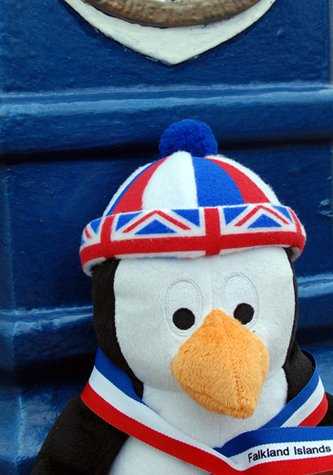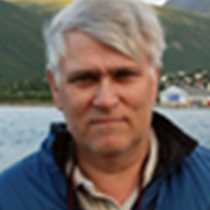Through the night we sailed around the northern and eastern sides of East Falkland, and as our wakeup call came through, we found ourselves alongside the floating dock in Stanley. Falkland has a long and complicated history, which in fact dates back to the Papal decree, set in 1493, to divide the world between the Portuguese and Spanish empires. The islands nowadays named Falkland were most likely first sighted by the English navigator Davis on his ship Desire, storm-driven from the coast of Patagonia in 1592. Davis was one of many English explorers sent out to harass the Spanish fleets bringing back gold and silver from South America but also finding new land to conquer. Davis’ name is immortalized in “Davis Strait” between Greenland and Baffin Island. The Spanish claimed the island because of the Papal decree, but both the English and French tried to settle the islands in the 1760s. Both settlements failed. In 1831 the U.S. Navy sloop Lexington dispersed the Argentinean garrison, which settled in 1829, and declared the territory “Terra nullis,” free for American whaling ships to get supplies on their routes to the Pacific hunting grounds. Many islands were stocked with pigs and cows that thrived inside the high tussock grass.
In 1833 the British reconstituted their ownership of the islands by settling in the former French settlement Port Louis. As the famous English navigator, James Ross with his two ships Erebus and Terror, came through in 1842 they found an even more sheltered location for ships. This became “Port Stanley” nowadays known by the locals as “Stanley.” At first, it was an important harbor for the sailing ships to seek shelter in for repairs after a harsh Drake Passage crossing and later an important coaling station for steamships. After the inaugural of the Panama Canal in 1914, Falkland Island became a forgotten outpost in the British Empire mainly retaining their living on sheep farming.
If yesterday was about the nature in the archipelago, today was more about the life of the approximately 2,500 islanders living here, with about 80% living in Stanley. A smorgasbord of options was offered and everyone had plenty to choose from to fill their time, both for the morning and later afternoon outings.
Of course as you step out on the floating dock it becomes evident, here in this part of the world, an ever-blowing wind from the west rules and most days you have a sky covered by grey clouds. The town tour took us through Stanley and our local guides gave a cheerful introduction to the history and life. Monuments were visited from both the Falkland Battle in 1914, one of the few marine battles during this war, and the invasion in 1982, including Thatcher Drive. We also had a visit to the brand new local museum. Wherever you are in Stanley it is always very evident you are in Britain, as there are signs all over the place, you do not need to look far. In fact it is today more “English” than England.
Those who wanted to learn more about the life outside the township of Stanley departed for a visit to a Long Island Camp, as any settlements outside of Stanley are called “Camps.” Here, life is still as it used to be and the peat is the main source for heating. Electricity is created by diesel generators and small wind-power mills. These camps are spread out on the island, and the only daily contact with the outside world is through Internet or phone. To reach most of them, as the roads are very few here, you need to fly or use an un-regular ship schedule that does bring supplies to the camps, although the camps are more or less self-sufficient with food. Sheep farming is still the major occupation.
In the afternoon some went to visit our supplier of vegetables, Stanley Growers Hydroponic Gardens. It is just a short walk from our ship. Today Tim Miller supplies, with his hydroponic gardens, all the locals in Stanley with vegetables from early spring, October, to early fall in April. It also includes the military base at the airport, Mt. Pleasant, built after the invasion. Additionally, visiting expedition ships are able to lay their hands on fresh vegetables. As we are in Britain, the tour of course ended with a typical English 4 o’clock tea in the garden of Miller’s.
A different option was the hike at Mount William. Here you are able to encounter the strange ‘stone runs’ that Darwin had a hard time understanding and explaining during his visit with the ship Beagle in 1832. Also during the 1982 conflict, Mount William was one of many battlefields, used by the British troops as they were about to take over the control of Stanley.
The day started as usual here in the South Atlantic with high winds and a very grey sky. As the day progressed, blue sky and sunshine prevailed. Although Argentina still maintains their claim to Isla Malvinas, certainly when we arrive back in Ushuaia they will still claim we never left Argentina. For sure, after a full day in Stanley there is no doubt whatsoever, the people living here are very British and will stay so.
As we cast the lines and slowly made our way out from the sheltered bays of Stanley, during Recap an interesting summary was made of the days and visits to these rather isolated islands. These islands are in the very far south of the South Atlantic and stretch from marooned New England sealers at New Island early 19th century, to the Falkland Battle December 8, 1914, to the early stages of World War I, through the invasion in 1982, to the soon upcoming hydro-carbon era, which is set to boom here and totally change the life on the islands. Good or bad, only the future will tell. Now we are heading for South Georgia and have two sea days to summarize our Falkland impressions and photos and also prepare us for our next landfall below the Antarctic convergence. Stanley was during the Heroic age, much a gateway for many expeditions to the far south, and we are about to follow.







